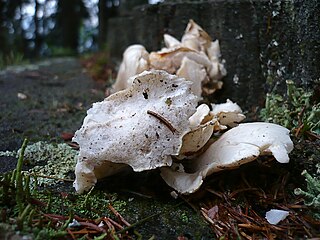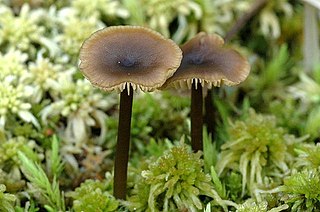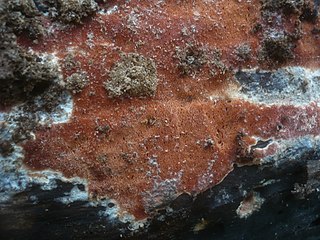
A basidium (pl. basidia) is a microscopic sporangium found on the hymenophore of fruiting bodies of basidiomycete fungi which are also called tertiary mycelium, developed from secondary mycelium. Tertiary mycelium is highly-coiled secondary mycelium – a dikaryon. The presence of basidia is one of the main characteristic features of the Basidiomycota. A basidium usually bears four sexual spores called basidiospores; occasionally the number may be two or even eight. In a typical basidium, each basidiospore is borne at the tip of a narrow prong or horn called a sterigma (pl. sterigmata), and is forcibly discharged upon maturity.

The Cantharellaceae are a family of fungi in the order Cantharellales. The family contains the chanterelles and related species, a group of fungi that superficially resemble agarics but have smooth, wrinkled, or gill-like hymenophores. Species in the family are ectomycorrhizal, forming a mutually beneficial relationship with the roots of trees and other plants. Many of the Cantharellaceae, including the chanterelle, the Pacific golden chanterelle, the horn of plenty, and the trumpet chanterelle, are not only edible, but are collected and marketed internationally on a commercial scale.

The Clavulinaceae are a family of fungi in the order Cantharellales. The family is not well defined, but currently comprises species of clavarioid fungi as well as some corticioid fungi. These species are nutritionally diverse, some being ectomycorrhizal, others wood-rotting saprotrophs, others lichenized, and yet others lichenicolous.

Rigidoporus is a genus of fungi in the family Meripilaceae. Many of the species in this genus are plant pathogens. The widespread genus, which contains about forty species, was originally circumscribed by American mycologist William Alphonso Murrill in 1905. The generic name combines the Latin word rigidus ("rigid") with the Ancient Greek word πόρος ("pore").

The Phanerochaetaceae are a family of mostly crust fungi in the order Polyporales.

Peniophora is a genus of fungi which are plant pathogens. Members of the genus belong to the class Agaricomycetes, order Russulales, and family Peniophoraceae. The genus is widespread, and contains 62 species. The species of Peniophora are resupinate, or crust-like, and are described as corticioid. A number of its members are parasitised by other fungi. For example, Tremella mesenterica is a parasite to several species of Peniophora.

Phlebia is a genus of mostly crust fungi in the family Meruliaceae. The genus has a widespread distribution. Phlebia species cause white rot.
Heteromyces is a genus of lichenized fungi in the family Cladoniaceae. It is a monotypic genus, containing the single species Heteromyces rubescens. Both the genus and species were described by Swiss lichenologist Johannes Müller Argoviensis in 1889. The name Heteromyces was also used for a genus circumscribed by Lindsay S. Olive in 1957; this usage is illegitimate because of the prior usage of this name by Müller. Olive's concept of Heteromyces was renamed to Oliveonia by Marinus Anton Donk in 1958.

Climacocystis is a genus of poroid fungi in the family Fomitopsidaceae. Until recently, it was monotypic genus, containing the single widespread species Climacocystis borealis. In 2014, Chinese mycologists added the newly described species Climacocystis montana. The generic name combines the name Climacodon with the Ancient Greek word χύστιζ ("bladder").

Osteina is a fungal genus in the family Fomitopsidaceae. It is a monotypic genus that contains the single species Osteina obducta. The genus was circumscribed by mycologist Marinus Anton Donk in 1966, with Polyporus obductus as the type species.

Rhizoctonia is a genus of fungi in the order Cantharellales. Species form thin, effused, corticioid basidiocarps, but are most frequently found in their sterile, anamorphic state. Rhizoctonia species are saprotrophic, but some are also facultative plant pathogens, causing commercially important crop diseases. Some are also endomycorrhizal associates of orchids. The genus name was formerly used to accommodate many superficially similar, but unrelated fungi.

The Ceratobasidiaceae are a family of fungi in the order Cantharellales. All species within the family have basidiocarps that are thin and effused. They have sometimes been included within the corticioid fungi or alternatively within the "heterobasidiomycetes". Species are saprotrophic, but some are also facultative plant pathogens or are associated with orchid mycorrhiza. Genera of economic importance include Ceratobasidium and Rhizoctonia, both of which contain plant pathogenic species causing diseases of commercial crops and turf grass.

Tephrocybe is a genus of about 40 species of mushroom, with a widespread distribution in temperate areas. The genus was circumscribed by Dutch mycologist Marinus Anton Donk in 1962.

The Punctulariaceae are a family of fungi in the order Corticiales. The family in its current sense is based on molecular research and contains just three genera of corticioid fungi.

Tulasnella is a genus of effused (patch-forming) fungi in the order Cantharellales. Basidiocarps, when visible, are typically smooth, ceraceous (waxy) to subgelatinous, frequently lilaceous to violet-grey, and formed on the underside of fallen branches and logs. They are microscopically distinct in having basidia with grossly swollen sterigmata on which basidiospores are formed. One atypical species, Tulasnella aurantiaca, produces orange to red, gelatinous, pustular anamorphs on wood. Some species form facultative mycorrhizas with orchids and liverworts. Around 80 species of Tulasnella are known worldwide.

Xenasma is a genus of corticioid fungi in the order Polyporales. It was circumscribed by mycologist Marinus Anton Donk in 1957.

Dentipratulum is a genus of fungi in the family Hericiaceae. It was circumscribed by Dutch mycologist Marinus Anton Donk in 1962. Species in the genus have membranous fruit bodies that are either completely resupinate or effuso-reflexed. The hymenium bears "teeth".

Ceriporia purpurea is a species of crust fungus in the family Irpicaceae. It was first described by Swedish mycologist Elias Magnus Fries in 1821 as Polyporus purpureus. Marinus Anton Donk gave the fungus its current name when he transferred it to the genus Ceriporia in 1971.

Botryobasidium is a genus of corticioid fungi belonging to the order Cantharellales. Basidiocarps are ephemeral and typically form thin, web-like, white to cream, effused patches on the underside of fallen branches, logs, and leaf litter. Several species form anamorphs producing chlamydospores. All species are wood- or litter-rotting saprotrophs and the genus has a worldwide distribution.

Tulasnella aurantiaca is a species of fungus in the order Cantharellales. It produces orange-red, pustular, gelatinous anamorphic states on dead, deciduous wood. Originally described from Europe, it also occurs in North America where the species appears to be more common.


















